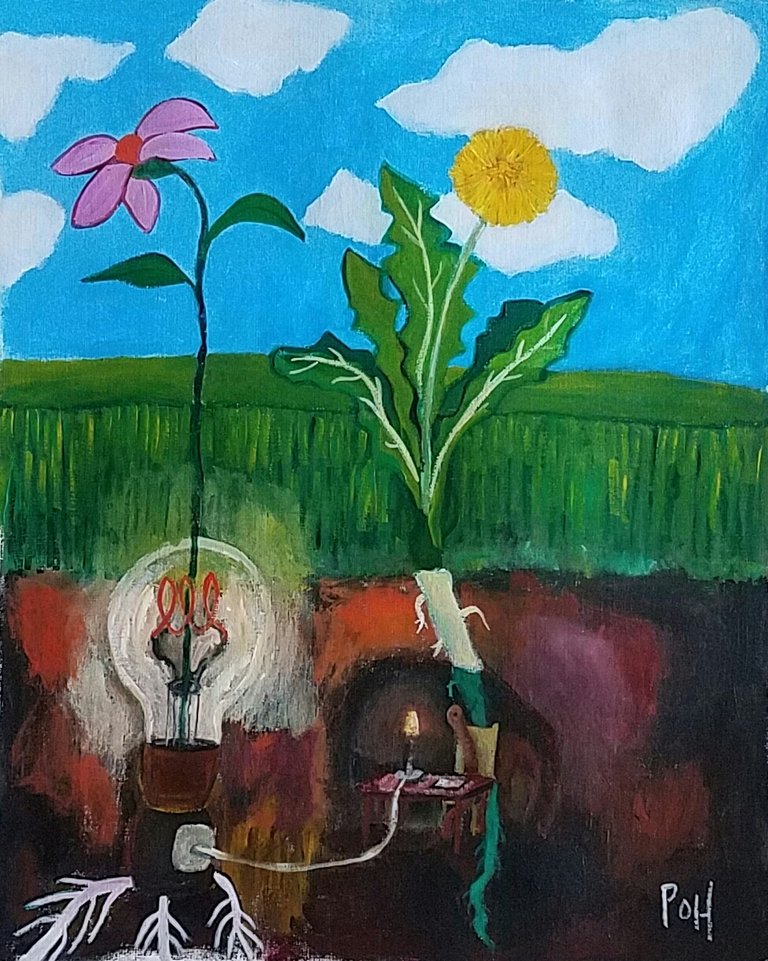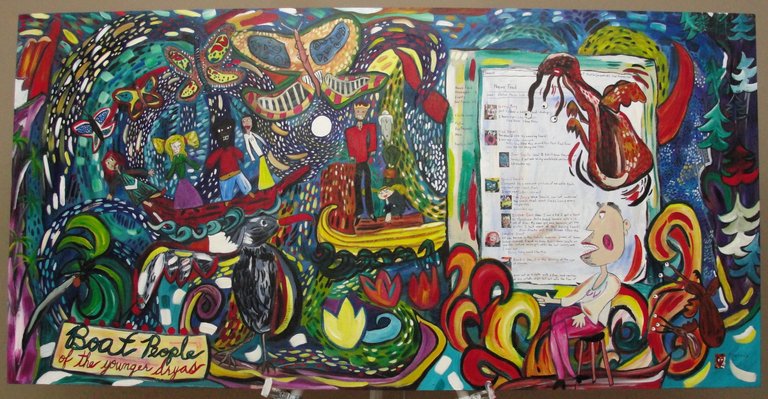Boat People of the Younger Dryas 2010. Acrylic on wood, 48 x 24"
The Ancestors. Sounds like an 80’s mini-series, rife with English accented great grandparents stepping off the boat from Italy with “party in the back” mullets, pink lipstick, and Cyndi Lauper as lead role, a Milan Bowery girl seeking fame and fortune on Broadway.
Might as well be since we know so little about our true ancestors, except how their existence defines (wrongly) “where we come from”. Am I Irish, Italian, West African, Northern European, etc.? Well, you’re none of these things, Central African brothers and sisters. Those people were just passing through, too, like you. Theoretically all humans today are incestral offspring from the same cave-dwelling parents near the Horn of Africa. Science takes over where history stops, and it says you can’t just cease descending when there’s nothing left to read about it. Illiterate ancients still have something to tell us about the past, even if modern Homo sapien is too focused on its own written history which covers only the last 5,000 years in the existence of a species dating back to 297,000 B.C.E. And the search doesn’t end there. Homo sapien grandmothers of the first eon must cross species to study their ancestors, Homo heidelbergensis, Homo erectus, and Homo neandethalensis, to name just a few. Yet all they had to rely on was an oral history to grunt about, if old grunts could be understood with Rosetta Stone-like ballads of the caves.
So although one may prove paternal connection to a Scottish King or French playwright, it might behoove our endangered species in an era of climate disruption to know how our naked 12,000x great grandmothers set the boulder for Thanksgiving.
Or perhaps we need not go that far back in time, depending on what survival tips passed down from the more recent past might be helpful to our progeny. I believe the antidote to runaway carbon belching are lifestyles practiced by ALL ancestors two or three hundred years ago, depending on what part of the earth they inhabited. Then it might very well matter if your descendants were from England or Egypt. Their published tips on living the good life had books but no cars, tables not turbines, communal protection without nuclear Armageddon, but most importantly, knowledge of locale—the most practical way to live with the nature provided. We must reset the bar of sustainability achievement to where human life was before the invention and practical (greedy) use of the steam engine. For instance, winters in Central New York were just as harsh as today, yet surmountable without central heating and iPhone data.
However, let’s keep the good stuff. Electricity conversion to power the Internet, and provide minimal lighting and steady heat and cooling sourcing to individuals and all life-giving and care facilities. Why go back to cholera when we can take along a water treatment plant? Modern advancements in medicine, surgery, immunology, etc. will go a long way in a past restart to our future success as a species. These facilities receive total community support for continuance. That is, we manufacture what will keep the least fortunate among us content and healthy. Steel plants exist, though not for profit. Break down and reuse the cities. Spread out far and wide using resources of stuff that has already been made. Make space for elder care havens and prosthetic limb factories. Plane travel outlawed. Train travel okay but highly regulated. Car travel as cold and dead as a Henry Ford scapula. Food sources localized to a 100 mile radius. No more CAFOs or cat food. No domestic pets! Befriend wildlife, but for our sake, keep it wild.
At present, in the United States, 40% of arable soil is working farmland. 915 million acres. This does not include what pollutes now as Mcmansions, car lots, and Walmarts. With a current population of 333 million, the working land could be divvied up to provide 2.8 acres (but no mule) per person. With zero population growth, this is more than enough space to pass on for several generations. Not to mention the abundance of land for the myriad communal living configurations necessary for those unable to care for themselves. And still plenty of room left over outside our living boundaries to manufacture what is needed (not wanted) on a national scale. And wild spaces preserved.
A pipe dream proposal? As it stands, alone in my room, yes. But this is just one man’s musings on a Saturday morning in abundant Candyland, searching for a light at the end of tunnel vision civilization. There are a million paths to sustainability, but until some engineering genius invents a device to blow out endless tons of atmospheric carbon into outer space, I believe measurable success must begin with a monumental reduction in energy use. The United States is 4% of the world population gobbling up 23% of its resources. One fat American uses as much energy as 128 Bangladeshis. The latter nation of Homo sapiens have joy, sorrow and overpopulation too. But they’re just not nearly as disgusting.
I believe there are answers to life and death questions of sustainability found in the world of our ancestors who lived before the industrial revolution (billionaire takeover) ensnared humanity to suffer what need not be inevitable. Basically, if a modern Bangladeshi can do it, then so can you. But you’ll need to take out two bathrooms, a first and second car, a job you never wanted anyway, and all Home Depots.
In time I plan to convince you to do just that, with allusions to living the good life, spelled out for us in detail by literate ancestors (pre-industrial revolution). Their existence was one of (dis)natural harmony. No matter how bad things got, they carried on without threat to millions of other planetary species. Simply put, they lived better than us with less, so much less. And the lighter greed of their world, before interchangeable parts, kept mankind a stable equal among all life on earth. People might declare the end of the world, but it had to be approved by a super God. Townsfolk could imagine global warming, but until the post-pubescent thinking of Thomas Edison, a light bulb was just another flower to plant in spring—not a sinister invention to initiate our doom.

1844 Light Bulb 2020. Acrylic on paper, 16 x 20"

Congratulations @ronthroop! You have completed the following achievement on the Hive blockchain And have been rewarded with New badge(s)
You can view your badges on your board and compare yourself to others in the Ranking
If you no longer want to receive notifications, reply to this comment with the word
STOP